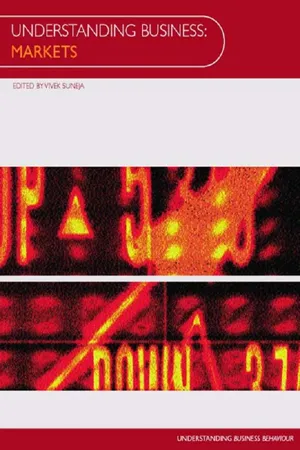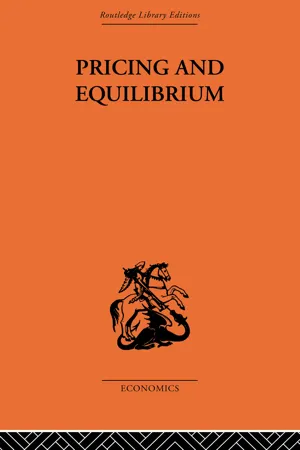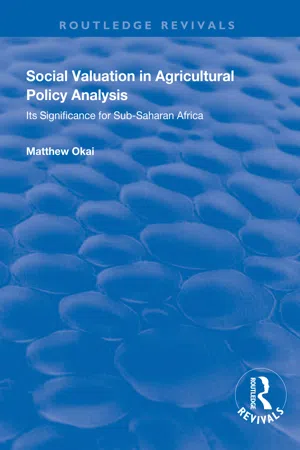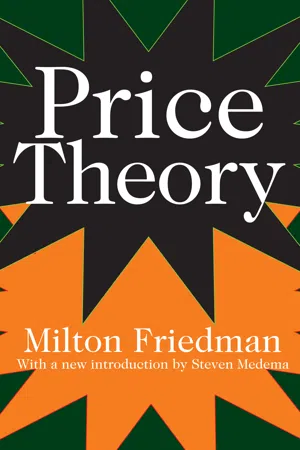Economics
Income Elasticity of Demand
Income Elasticity of Demand measures the responsiveness of the quantity demanded of a good to changes in income. It is calculated as the percentage change in quantity demanded divided by the percentage change in income. A positive income elasticity indicates that demand for the good increases as income rises, while a negative elasticity suggests the opposite.
Written by Perlego with AI-assistance
Related key terms
12 Key excerpts on "Income Elasticity of Demand"
- eBook - ePub
Understanding Business: Markets
A Multidimensional Approach to the Market Economy
- Vivek Suneja, Vivek Suneja(Authors)
- 2005(Publication Date)
- Routledge(Publisher)
extent to which demand changes as income changes. Income Elasticity of Demand measures the sensitivity of demand to changes in income. If consumers get an increase in income, their demand for some products may rise substantially, but their demand for other products may rise only very slightly, if at all.Income Elasticity of Demand can be measured by using the formula:If the value is more than one, demand is said to be income elastic, and if the answer is between zero and one, demand is said to be income inelastic. Most goods will fall into this range: that is, their Income Elasticity of Demand will be positive, and the higher the value of the Income Elasticity of Demand, the stronger the relationship is between changes in income and changes in demand. Luxury products tend to have a high income elasticity, while necessities have a low income elasticity. Thus the demand for foreign holidays or eating out is likely to be fairly responsive to changes in income, but the demand for bread is unlikely to change by much as income changes.For some products, however, the Income Elasticity of Demand is negative, and these are referred to as inferior products. For these products there is an inverse relationship between income and demand, and an increase in income will lead to a fall in demand. The explanation for this is that as their income rises, consumers substitute better products in place of the ‘inferior’ products. Typical examples are public transport or cheap cuts of meat.Knowledge of the Income Elasticity of Demand is important as it can help us to predict what will happen to demand as income levels change. Over time, living standards and the level of income have a tendency to rise. Using data on the Income Elasticity of Demand for products, we can predict changes in spending patterns. We can expect to see a rise in spending on those products which have a high Income Elasticity of Demand, such as eating out, electrical goods, foreign holidays and leisure activities, whereas for those products which have a low Income Elasticity of Demand – for example, necessities such as bread, toothpaste, washing-up liquid – demand will rise only slightly. Expenditure on those products which have a negative income elasticity will fall. Thus the demand for public transport may fall as people switch to private cars. - eBook - ePub
Economics of Tourism and Hospitality
A Micro Approach
- Yong Chen(Author)
- 2021(Publication Date)
- Routledge(Publisher)
Y , for the good is given by the ratio of the percentage change in quantity demanded to the percentage change in consumer income:(5.11)η Y=(/)Q 2−Q 1Q 1(/)Y 2−Y 1Y 1.Similar to the other two ways of calculating the price elasticity above, we can calculate the midpoint Income Elasticity of Demand using formula (5.8) and the point Income Elasticity of Demand using formula (5.10) by simply replacing price P with income Y . Note that in the formulas for calculating the income elasticity we assume that the change in quantity demanded is due to the change in consumer income, other things being equal.The Income Elasticity of Demand allows us to further classify goods beyond normal goods versus inferior goods, which we addressed in Chapter 4 . Obviously, the Income Elasticity of Demand for normal goods is positive, denoted by curvesI 1,I 2, andI 3in Figure 5.4 . Very few goods are inferior goods with a negative income effect, and hence a negative income elasticity,I 4. Note that the distinction between normal goods and inferior goods is due to the nature of the relationship between demand and income with no regard to the magnitude of the income effect. Normal goods can be further classified as necessities and luxury goods based on the size of the income effect. The income elasticity of necessities is between 0 and 1, suggesting that a 1% increase (decrease) in income will lead to a less than 1% increase (decrease) in quantity demanded, denoted byI 2, other things being equal. The income elasticity of luxuries is greater than 1, suggesting that a 1% increase (decrease) in income will lead to a greater than 1% increase (decrease) in demand, denoted byI 3 - eBook - ePub
Economics for Investment Decision Makers
Micro, Macro, and International Economics
- Christopher D. Piros, Jerald E. Pinto(Authors)
- 2013(Publication Date)
- Wiley(Publisher)
It should be noted that the relationships just described hold for any demand curve, so it does not matter whether we are dealing with the demand curve of an individual consumer, the demand curve of the market, or the demand curve facing any given seller. For a market, the total expenditure by buyers becomes the total revenue to sellers in that market. It follows, then, that if market demand is elastic, a fall in price will result in an increase in total revenue to sellers as a whole, and if demand is inelastic, a fall in price will result in a decrease in total revenue to sellers. Clearly, if the demand faced by any given seller were inelastic at the current price, that seller could increase revenue by increasing the price. Moreover, because demand is negatively sloped, the increase in price would decrease total units sold, which would almost certainly decrease total cost. So no one-product seller would ever knowingly choose to set price in the inelastic range of the demand.4.3. Income Elasticity of Demand: Normal and Inferior Goods
In general, elasticity is simply a measure of how sensitive one variable is to change in the value of another variable. Quantity demanded of a good is a function of not only its own price, but also consumer income. If income changes, the quantity demanded can respond, so the analyst needs to understand the income sensitivity as well as price sensitivity.Income Elasticity of Demand is defined as the percentage change in quantity demanded divided by the percentage change in income (I ), holding all other things constant, and can be represented as in Equation 1-25 .(1-25)Note that the structure of this expression is identical to the structure of own-price elasticity in Equation 1-24 . Indeed, all elasticity measures that we will examine will have the same general structure, so essentially if you’ve seen one, you’ve seen them all. The only thing that changes is the independent variable of interest. For example, if the Income Elasticity of Demand for some good has a value of 0.8, we would interpret that to mean that whenever income rises by 1 percent, the quantity demanded at each price would rise by 0.8 percent.Although own-price elasticity of demand will almost always be negative because of the law of demand, income elasticity can be negative, positive, or zero. Positive income elasticity simply means that as income rises, quantity demanded also rises, as is characteristic of most consumption goods. We define a good with positive income elasticity as a normal good - eBook - ePub
A Primer on Microeconomics, Second Edition, Volume I
Fundamentals of Exchange
- Thomas M. Beveridge(Author)
- 2018(Publication Date)
- Business Expert Press(Publisher)
: Note that the financial term is in the denominator and the “numbers” term is in the numerator, as we saw with price elasticity of demand and as we’ll see again with the other elasticity formulas that follow. This is the typical “elasticity” pattern.Figure 4.4 summarizes what we have learned so far about Income Elasticity of DemandThe farther from zero (no response) we go, in either direction, the greater the buyers’ response to a change in income. Goods whose income elasticity exceeds + 1.0 are sometimes termed “luxury” or “supernormal” goods.The Income Elasticity of Demand for cars is very high (+ 2.46, according to one study). What does this value mean? First, because the number is positive, we know that this is a normal good. Choosing 10 percent as a convenient value for the percentage change in income, we get:Y = %ΔD/+ 10 = + 2.46Solving this, the percentage increase in the demand for cars would be 24.6 percent if income increased by 10 percent. You can see why executives in the car industry would be concerned if there was a likelihood of recession!The Income Elasticity of Demand for public transport is negative (–0.36, according to a study). Because the number is negative, we know that this is an inferior good. Again, choosing 10 percent as a convenient value for the percentage change in income, we get:Yd , = %ΔD/ + 10 = –0.36Solving this, the percentage decrease in the demand for public transport would be 3.6 percent if income increased by 10 percent. We would predict increased ridership on public transport during an economic slowdown.Challenge : Many states have introduced lotteries. One argument against lotteries is that they act like a tax (albeit a voluntary one), and that poor citizens tend to be taxed more. If so, then lotteries may be thought of a form of regressive taxation. A study showed that the Income Elasticity of Demand for lottery tickets was –0.1. Does this evidence lend support to the objection that lottery tickets are a method of regressive taxation?Cross-Price Elasticity of DemandCross-price elasticity of demand (Xd ) measures the degree by which the demand for one good changes when the price of a related good changes. In Chapter 2 , we learned that if the price of Good B increases, then the demand for a substitute Good A will increase—there is a positive relationship between “percentage change in the price of Good B” and “percentage change in the demand for Good A” when the goods are substitutes. If the price of Coca-Cola increases (+ ), then consumer demand for Pepsi will increase (+ ). By contrast, the relationship will be negative in the case of complements. If the price of beer increases (+ ), then consumer demand for beer nuts will decrease (− - eBook - ePub
- Erich Schneider(Author)
- 2013(Publication Date)
- Routledge(Publisher)
ceteris paribus ) with an increase in income, and decreases only in the exceptional case of inferior goods. By using the concept of income elasticity we can now formulate this relation as being such that, in the regular case, income elasticity is positive, and in the exceptional case negative. The exact magnitude of income elasticity at a particular level of income is, of course, specially significant. For the usual case there are two different possibilities to be distinguished:(a) If the income elasticity is positive and greater than 1, then one says that demand is elastic with respect to income . A change in income of 1% then corresponds to a change in the quantity demanded of more than 1%.(b) If the income elasticity is positive but smaller than 1, then we say that demand is inelastic with respect to income . An income change of 1% then corresponds to a change in demand of less than 1%.Positive income elasticities smaller than 1 are found in the case of important consumers’ goods the need for which is already met to a considerable extent by small or moderate incomes (e.g. housing requirements).(c) If the income elasticity is nil, then we say that demand isperfectly inelastic with respect to income .The size of the income elasticity for particular goods can be taken as a criterion for distinguishing between essential and non-essential goods, if we define as essential goods those with an income elasticity smaller than 1, and as non-essentials those with an income elasticity greater than 1. We must notice here that the size of the income elasticity of a household’s demand for a particular good varies with the level of its income, and, therefore, the dividing line between the two kinds of goods is not clear-cut. A good which is “non-essential” at a particular level of income can become “essential” at another level. - eBook - ePub
Microeconomic Principles and Problems
A Pluralist Introduction
- Geoffrey Schneider(Author)
- 2024(Publication Date)
- Routledge(Publisher)
We see something similar with airline travel. People booking airline tickets at the last minute tend to have extremely inelastic demand curves: They are traveling for an important business meeting or family emergency, and they are willing to pay a high price. But people booking air travel far in advance, for their next vacation in six months, will shop around and will consider alternative modes of transportation if the price of an airplane ticket is too high, making their demand more elastic. Airlines, of course, take advantage of this as much as they can. They sell advance tickets for lower prices to lure long-run purchasers with elastic demand curves, but as seats become more scarce and as the departure date nears, airline tickets jump in price because airlines know that last-minute travelers have few options and hence a very inelastic demand curve.Price elasticity of demand is the most important and useful type of elasticity. But there are other types of elasticity that can be helpful in analyzing the demand for particular products. These include Income Elasticity of Demand and cross-price elasticity of demand.10.7 INCOME ELASTICITY AND CROSS-PRICE ELASTICITY OF DEMAND
10.7.1 Income Elasticity of Demand
Income Elasticity of Demand is important in telling us how particular markets will respond to changes in income due to the business cycle. In recessions, when incomes fall dramatically, those goods that are highly sensitive to changes in income—that have large income elasticities of demand such as automobiles, vacations, and housing—will take a big hit. But inferior goods, with negative income elasticities of demand, will actually see sales increase when incomes fall.Income Elasticity of Demand (eGDP )measures the responsiveness of the quantity demanded to changes in income (GDP):e=G D P=% c h a n g e i n q u a n t i t y d e m a n d e d% c h a n g e i n i n c o m e% ▵Q D% ▵ G D PEconomists determine how much the demand curve shifts in response to a change in income via the Income Elasticity of Demand. Normal goods have an income elasticity of greater than 0: eGDP > 0. When incomes increase, the demand for normal goods also increases, shifting to the right. Examples of normal goods from Figure 10.17 - eBook - ePub
Microeconomic Theory second edition
Concepts and Connections
- Michael Wetzstein(Author)
- 2013(Publication Date)
- Routledge(Publisher)
∂Q/∂I)(I/Q ). Income Elasticity of Demand measures the percentage change in quantity to a percentage change in income, and is classified as follows:Table 5.3 lists the income elasticities for various foods, new automobiles, and gasoline. From this table, automobiles, fruits, and juices are luxury goods (η Q > 1), whereas bread, poultry, vegetables, and gasoline are necessary goods (η Q < 1). Considering the income elasticity of a new automobile ηQ = 1.70, a 1 percent increase in I results in a 1.7 percent increase in new automobile purchases.Income elasticity (η ) The percentage change in quantity given a percentage change in income. E.g., if the Income Elasticity of Demand for DVD players is 3, a 1 percent increase in income would result in a 3 percent increase in demand for DVD players .Table 5.3 Estimated income elasticitiesCommodity Income elasticities Fooda Bread 0.578 Poultry 0.900 Vegetables 0.976 Fruit 1.160 Juice 1.042 Automobilesb 1.70 Gasolinec Short run 0.47 Long run 0.88 a K.S. Huang and B.-H. Lin, “Estimation of Food Demand and Nutrient Elasticities from Household Survey Data,” Economic Research Service, USDA, Technical Bulletin Number 1887, 2000.b P.S. McCarthy, “Market Price and Income Elasticities of New Vehicles Demand,” Review of Economics and Statistics 78 (1996): 543–547.c M. Espey, “Gasoline Demand Revisited: An International Meta-Analysis of Elasticities,” Energy Economics 20 (1998): 273–295.Table 5.4 Estimated cross-price elasticities of demand for selected food commoditiesSource - Peter Davis, Eliana Garcés(Authors)
- 2009(Publication Date)
- Princeton University Press(Publisher)
15,000 cars would be at most 1,000. On the other hand, the same total income divided more equally could certainly generate sales of more than 1,000. (For recent work, see, for example, Lewbel (2003) and references therein.)1.1.2 Demand Elasticities
Elasticities in general, and demand elasticities in particular, turn out to be very important for lots of areas of competition policy. The reason is that the “price elasticity of demand” provides us with a unit-free measure of the consumer demand response to a price increase.7 The way in which demand changes when prices go up will evidently be important for firms when setting prices to maximize profits and that fact makes demand elasticities an essential part of, for example, merger simulation models.1.1.2.1 Definition
The most useful measurement of the consumer sensitivity to changes in prices is the “own-price” elasticity of demand. As the name suggests, the own-price elasticity of demand measures the sensitivity of demand to a change in the good’s own-price and is defined asThe demand elasticity expresses the percentage change in quantity that results from a 1% change in prices. Alfred Marshall introduced elasticities to economics and noted that one of their great properties is that they are unit free, unlike prices which are measured in currency (e.g., euros per unit) and quantities (sales volumes) which are measured in a unit of quantity per period, e.g., kilograms per year. In our example in figure 1.1 the demand elasticity for a price increase of 10 leading to a quantity decrease of 5 from the baseline position, where P = 60 and Q = 20, isηjj= (−5/20)/(10/60) = −1.5.For very small variations in prices, the demand elasticity can be expressed by using the slope of the demand curve times the ratio of prices to quantities. A mathematical result establishes that this can also be written as the derivative with respect to the logarithm of price of the log transformation of demand curve:- eBook - ePub
Microeconomics
A Global Text
- Judy Whitehead(Author)
- 2014(Publication Date)
- Routledge(Publisher)
- Where the tangent at any point on the Engel curve does not extend as far as the origin (such as at the point R ) then the Income Elasticity of Demand at that point is less than one, or:
ηY< 1- At the turning point D , the Income Elasticity of Demand is zero . This is because the numerator (difference between the perpendicular and the tangent) is zero, since the perpendicular DV is also the tangent to the point D . Hence:
- For points beyond the turning point D, where the tangent intersects the X -axis to the right of the perpendicular from the turning point (DV), then the income elasticity is negative. That is:
In general, the Income Elasticity of Demand decreases as real income increases. Furthermore:ηY< 0.- For a superior good: ηY> 1
- For a normal good: 1 < ηy> 0
- For an inferior good: ηy< 0
3.3.3 Application of Income Elasticity of Demand
The following are features of the Income Elasticity of Demand:- Income Elasticity of Demand may be used to classify goods into luxuries or necessities. It may also be used to give an indication of the state of development of a country.
- A high value for Income Elasticity of Demand (greater than one) implies that the commodity is a luxury. The importance of this is that, as real income increases, the demand for the commodity increases more than proportionately. This causes the demand curve for the commodity to shift outwards.
- A low but positive value for Income Elasticity of Demand (greater than zero but less than one) implies that the commodity is a necessity (i.e. quantity demanded not particularly responsive to income levels). Hence as real income increases, the demand for the commodity increases less than proportionately. The demand curve for the commodity still shifts outwards but only moderately so.
- eBook - ePub
Social Valuation in Agricultural Policy Analysis
Its Significance for Sub-Saharan Africa
- Matthew Okai(Author)
- 2019(Publication Date)
- Routledge(Publisher)
The Income Elasticity of Demand is the proportionate change in the quantity demanded of a commodity X as a result of proportionate change in income (or a percentage change in the demand of X in response to a 1 per cent change in income). The income elasticity, Ey, can be expressed asorEy =dx X/dy y(6)Ey =dx dyY X(7)The main determinants of income elasticity include: i) the nature of the need that the commodity satisfies. This may be explained by Engel’s Law, which states that the percentage of income spent on food declines as income rises. This principle can be used to classify goods into normal and inferior goods. If Ey remains positive then we have normal good, but if Ey is negative then the food is considered as being inferior. Normal goods may be further classified into necessities, inferior, and superior luxury goods; ii) the time period is also a factor because consumption patterns adjust, with a time-lag, to changes in income; and iii) the level of a country’s development, indicated by the level of income per head. The poorest group in society, for example, consume more of their total expenditure (or income) for basic food while the richest groups consume a larger share of their income in luxuries.The increase/decrease in the consumption of a given good when the total disposable income increases is measured by the income elasticity of the good. The income elasticity can range from negative to positive values and defines different categories of goods. As regards necessity goods, the elasticity is usually greater than 0 but lower than 1. In this case, the good consumption increases with the income but by a lower percentage. The marginal increase is lower the higher the disposable income and there tends to be a saturation point, after which consumption does not increase any more with income. As regards inferior goods, the elasticity is negative, as income increases correspond with a decrease in consumption. These are goods which have very close and better-quality substitutes. As income increases, consumers give up consumption of goods they consider inferior and shift their purchases to goods regarded as superior. Regarding superior/luxury goods, the elasticity is positive and greater than 1. The consumption of these goods increases by a percentage higher than the percentage increase in income. The demand curve of a given good can show different elasticities at different levels of income. A superior/ luxury good, for instance, can become a necessity good when a certain income threshold is reached. A necessity good can turn into an inferior good at high income levels. - eBook - ePub
- Milton Friedman(Author)
- 2017(Publication Date)
- Routledge(Publisher)
5FIGURE 2.17FIGURE 2.18As we have noted, income elasticity is frequently used to define the terms necessities and luxuries. A good is termed a “necessity” if its income elasticity is less than unity, a “luxury” if its income elasticity is greater than unity.Unit income elasticity for all commodities would mean that the income-expenditure path on an indifference curve diagram would be a straight line through the origin. From the definition of income elasticity, it follows that kxηx1+ kyηyI+ . . . = 1, where kx is the fraction of income spent on X, ky on Y, etc.; andηxIis the income elasticity of X,ηyIof Y, etc.The Three-Fold Classification Implicit in Indifference Curve Analysis
The analysis of consumer behavior in terms of indifference curves implicitly classifies all factors affecting consumer behavior into three categories: (1) goods—these are the axes of the indifference curves, (2) factors determining opportunities—these are summarized in the budget line, and (3) factors determining tastes—these are summarized in the indifference curves.The important thing about this classification is that it is not given, once for all. It is a classification the contents of which are to be determined by the problem at hand, so that the same factor may for one purpose be treated as a good and measured along the axes, for another as an opportunity factor, for another as a taste factor.To illustrate, consider regional location. For a person considering where to settle, it is clearly a good, to be measured on one of the axes. Once he has settled, it is an opportunity factor, since it will affect the prices he will have to pay for various goods and services, and also, a taste factor, since it may affect the importance he attaches to winter coats versus bathing suits, or heating versus air-conditioning. - eBook - ePub
- Stanley Bober(Author)
- 2016(Publication Date)
- Routledge(Publisher)
It is the level of real income that is the relevant and critical variable; in the main, a change in the price level is responded to via its effect on real income. Recall our basket-stacking–levee image, where it is the level of real income that determines the height of the levee and the fullness of the basket in relation to habit and convention. The connection between the proportion of one’s income spent on the various goods composing the different baskets (thereby satisfying different needs) and the change in the level of real income can be depicted via Engel curves.The first empirical observation on changes in the pattern of consumer expenditures in response to increases in income comes from a study by Ernst Engel in the mid-1850s. He studied the pattern of spending by workers in the German kingdom of Saxony and concluded that the proportion of income spent on food declines as income increases—a conclusion that become known as Engel’s law. But for our purposes it is the more general formulation of the law, as discussed by Pasinetti, that is essential; namely, “that the proportion of income spent on any type good changes as per capita income increases.”20 This broader statement has been confirmed by many econometric studies concerned with empirical work on demand.The reader will recall the analyses of income-elasticity of demand in the Principles course, with emphasis placed on the coefficient of elasticity sign being either positive or negative. In the latter instance the explanation customarily rests on the “inferiority” of the commodity, implying a commodity that one would purchase at very low (poverty) levels of income; at higher levels of income the good is totally eschewed in favor of goods fulfilling the same need but in a more “satisfactory” manner. The positive coefficient sign conveys to the student that beyond same threshold level of income all goods that the consumer has experience with are supposedly noninferior; and as income increases purchases will increase in accustomed proportion to income. Inferiority or noninferiority of goods would seem then to have everything to do with income levels. Now while this connection does exist, the emphasis given to it is much exaggerated; it is a relatively minor element. Goods may quickly become inferior for any level of income due to changes in convention and, perhaps more important, due to changes in the demand pattern of other consumers with whom a particular consumer relates. As one study cited in Lavoie concludes: “The consumption pattern of individual households is thus influenced by the demand structure of households with similar incomes or similar types of jobs, as it has been empirically shown.”21
Learn about this page
Index pages curate the most relevant extracts from our library of academic textbooks. They’ve been created using an in-house natural language model (NLM), each adding context and meaning to key research topics.











